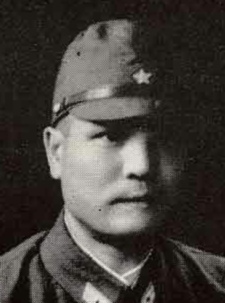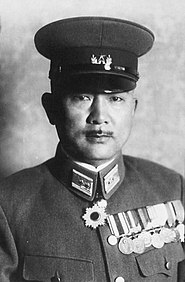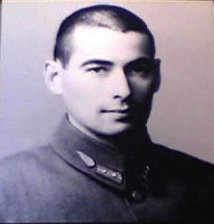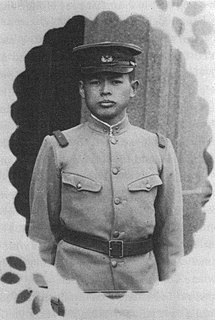 W
WKenshiro Abbe was a prominent Japanese master of judo, aikido, and kendo. He introduced aikido to the United Kingdom in 1955, and founded the Kyushindo system. Abbe was a graduate of the Budo Senmon Gakko, having studied judo and kendo there. Following an illustrious early career in the martial arts, he served in the Imperial Japanese Army before and during World War II. He then trained in aikido under its founder, Morihei Ueshiba, for a decade. Abbe held dan ranks in several martial arts, most notably 8th dan in judo, 6th dan in aikido, and 6th dan in kendo. After introducing aikido to the UK, he established several Japanese martial arts councils there during the late 1950s. He returned to Japan in 1964 and remained there for most of the remainder of his life. There are contradictory accounts of Abbe's final years, but it appears that he was in poor spirits and poor health towards the end.
 W
WHatazō Adachi was a general in the Imperial Japanese Army during World War II.
 W
WKorechika Anami was a general in the Imperial Japanese Army during World War II, and was War Minister at the time of the surrender of Japan.
 W
WRikichi Andō was a general in the Imperial Japanese Army and 19th and final Japanese Governor-General of Taiwan from 30 December 1944 to October 1945.
 W
WShigeo Arai was a Japanese freestyle swimmer who competed at the 1936 Olympics. He won a gold medal in 4 × 200 m freestyle relay, setting a world record. In the individual 100 m race he finished almost simultaneously with Masanori Yusa and Masaharu Taguchi and was awarded a bronze medal. Those Games were the only international competition for Arai, though he won three national titles in the 100 m and four in the 200 m freestyle between 1937 and 1940.
 W
WYukio Araki was a Japanese aviator of the Imperial Japanese Army during World War II. As a kamikaze pilot and member of the 72nd Shinbu Squadron, Araki's final mission took place on May 27, 1945 during the Battle of Okinawa when he flew his bomb-laden Mitsubishi Ki-51 to deliberately crash into the USS Braine. It is speculated that Araki and one other pilot are responsible for hitting the ship, killing 66 of its crew. At 17 years old, Araki is one of the youngest kamikaze pilots of World War II.
 W
WGeneral Prince Yasuhiko Asaka was the founder of a collateral branch of the Japanese imperial family and a career officer in the Imperial Japanese Army. Son-in-law of Emperor Meiji and uncle by marriage of Emperor Hirohito, Prince Asaka was commander of Japanese forces in the final assault on Nanjing, then the capital city of Nationalist China, in December 1937. He was a perpetrator of the Nanking massacre in 1937 but was never charged.
 W
WKitsuju Ayabe was a general in the Imperial Japanese Army during World War II.
 W
WMasao Baba was a general in the Imperial Japanese Army, commanding the Japanese ground forces of the Borneo Campaign of 1945 in the closing months of the war.
 W
WTakehiko Bessho , born Akira Bessho , was a Japanese baseball player whose professional career as a player lasted from 1942 until 1960. Bessho first achieved fame as a pitcher in Japanese professional baseball; later, he served as a Nippon Professional Baseball (NPB) manager.
 W
WYasuhito, Prince Chichibu , was the second son of Emperor Taishō (Yoshihito) and Empress Teimei (Sadako), a younger brother of Emperor Shōwa (Hirohito) and a general in the Imperial Japanese Army. As a member of the Imperial House of Japan, he was the patron of several sporting, medical, and international exchange organizations. Before and after World War II, the English-speaking prince and his wife attempted to foster good relations between Japan and the United Kingdom and enjoyed a good rapport with the British royal family. As with other Japanese imperial princes of his generation, he was an active-duty career officer in the Imperial Japanese Army. Like all members of the imperial family, he was exonerated from criminal prosecutions before the Tokyo tribunal by Douglas MacArthur.
 W
WIsamu Chō was an officer in the Imperial Japanese Army known for his support of ultranationalist politics and involvement in a number of attempted coup d'états in pre-World War II Japan.
 W
WChung Il-kwon, and was also known by the Japanese pronunciation of his name - Ikken Tei was a South Korean politician, diplomat, and soldier. A general in the Republic of Korea Army, he served as Foreign Minister 1963 to 1964, and Prime Minister from 1964 to 1970. He was an ally of President Park Chung-hee.
 W
WKenji Doihara was a Japanese army officer. As a general in the Imperial Japanese Army during World War II, he was instrumental in the Japanese invasion of Manchuria for which he earned the nickname "Lawrence of Manchuria," a reference to Lawrence of Arabia. However, according to Jamie Bisher, the flattering sobriquet was rather misapplied, as that Colonel T.E. Lawrence had fought to liberate, not to oppress people.
 W
WKeisuke Fujie was a general in the Imperial Japanese Army in World War II. Fujie’s wife was the daughter of Prime Minister Kantarō Suzuki.
 W
WIwaichi Fujiwara was an officer in the Imperial Japanese Army in World War II, and later a lieutenant general in the post-war Japan Ground Self Defense Force.
 W
WFumitaka Konoe was the eldest son and heir of Prime Minister Fumimaro Konoe and the 13th generation descendant of Emperor Go-Yōzei. He served as First Lieutenant in the Imperial Japanese Army in World War II, and died in detention in the Soviet Union.
 W
WMotoo Furushō was a lieutenant general of the Imperial Japanese Army and commander of the Japanese Twenty-First Army in 1938 during the Canton Operation.
 W
WFusaki Tsutsumi was a career military officer and a lieutenant-general of the Imperial Japanese Army in World War II.
 W
WUrzhin Garmaev - was a White Army officer, lieutenant general of the Japanese controlled Manchukuo Imperial Army, headmaster of the Xing'an Military School.
 W
WMajor Kenji Hatanaka was a Japanese military officer and one of the chief conspirators in the Kyūjō incident, a plot to seize the Imperial Palace and to prevent the broadcast of Emperor Hirohito's surrender speech to mark the end of World War II.
 W
WTomitarō Horii was a lieutenant general in the Imperial Japanese Army during World War II. After graduating from the Imperial Japanese Army Academy in 1911, Horii served in China before undertaking a variety of regimental appointments. Following Japan's entry into World War II, he commanded a division during the capture of Guam before commanding the Japanese force that had been given the task of capturing Port Moresby. In November 1942, in the retreat from Oivi–Gorari, Horii drowned while attempting to canoe down the Kumusi River to reach Japanese forces defending Buna–Gona. His canoe was swept out to sea and capsized.
 W
WKiyonao Ichiki was an officer in the Japanese Imperial Army in World War II. Ichiki commanded the 28th Infantry Regiment "Ichiki detachment" in the Battle of the Tenaru. The regiment was disastrously defeated by the 1st Marine Regiment and of the 917 soldiers of Ichiki's 1st echelon, only 128 survived. Ichiki was either killed during the final stages of the battle, or performed ritual suicide (seppuku) shortly thereafter.
 W
WTateo Katō was a Japanese ace army aviator, credited with at least 18 aerial victories and who was honored posthumously by an award of the Order of the Golden Kite.
 W
WTatsugo Kawaishi was a Japanese swimmer who competed at the 1932 Summer Olympics in Los Angeles.
 W
WYoshiyuki Kawashima was a general in the Imperial Japanese Army and Army Minister in the 1930s.
 W
WGeneral Tadamichi Kuribayashi was a general in the Imperial Japanese Army, part-time writer, haiku poet, diplomat, and commanding officer of the Imperial Japanese Army General Staff. He is best known for having been the overall commander of the Japanese garrison during the Battle of Iwo Jima.
 W
WRyō Kurusu was an officer in the Imperial Japanese Army. He is noted for being the only Eurasian person to be commemorated in Japan's Yasukuni Shrine.
 W
WMarquis Toshinari Maeda , was a Japanese general and the first commander of the Japanese forces in northern Borneo in World War II.
 W
WKiyoshi Miki was a Japanese philosopher, literary critic, scholar and university professor. He was an esteemed student of Nishida Kitarō and a prominent member of the Kyoto School.
 W
WLieutenant General Takeshi Mori commanded the Japanese Empire's First Imperial Guards Division at the very end of World War II. He was murdered by Major Kenji Hatanaka during the Kyūjō Incident.
 W
WPaul Nobuo Tatsuguchi , sometimes mistakenly referred to as Nebu Tatsuguchi, was a surgeon in the Imperial Japanese Army (IJA) during World War II. He was killed during the Battle of Attu on Attu Island, Alaska, United States on May 30, 1943.
 W
WMasayoshi Uchida was a Japanese swimmer. He competed in two swimming events and the diving at the 1920 Summer Olympics. He was killed in action during World War II.